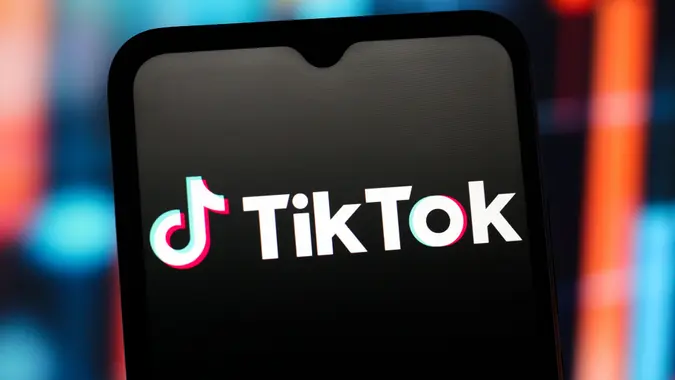Cash Advance vs. Payday Loan: What’s the Difference?

Commitment to Our Readers
GOBankingRates' editorial team is committed to bringing you unbiased reviews and information. We use data-driven methodologies to evaluate financial products and services - our reviews and ratings are not influenced by advertisers. You can read more about our editorial guidelines and our products and services review methodology.

20 Years
Helping You Live Richer

Reviewed
by Experts

Trusted by
Millions of Readers
A cash advance allows you to borrow cash against your credit card limit or earned income. A payday loan is a small-dollar, short-term loan typically provided by a specialty lender. Both are fast ways to get cash, but can cost you handsomely.
Still, cash advances and payday loans are an option if you’re in a financial jam with limited access to traditional financing, like a personal loan. Here’s how to decide which one is right for you.
Key Differences Between a Cash Advance and Payday Loan
| Feature | Credit Card Cash Advance | Cash Advance App | Payday Loan |
|---|---|---|---|
| Funds received | Seconds to minutes | Minutes to 5 business days | Minutes to hours |
| Borrowing amounts | $100 to 30% of your credit limit | $20 to $500 | $500 or less |
| Loan term | Minimum due every 28 to 31 days | 30 to 35 days | 2 to 4 weeks |
| Interest type | Compounding | – Uses a subscription model – May charge a fee or percentage of an advance |
Uses a fee structure, usually a set amount for every $100 borrowed |
| Interest rate | 20% to 30% APR | N/A | Equivalent to 400% APR |
| Collateral required? | No | No, but you usually need a bank account | No |
| Credit check required? | No | No | No |
| Best for | Credit cardholders | People with a steady paycheck | People with no other borrowing options |
What Is a Cash Advance?
Here’s a quick guide on cash advances and what’s important to consider.
How It Works
The most common way to get a cash advance is at an ATM. You’ll visit the ATM, insert your credit card and follow the prompts.
Most of the time, there’s a limit of 30% of your credit limit on cash advances. The APR on cash advances also ranges from 20% to 30%, with interest accruing immediately.
You’ll also need to pay a separate cash advance fee, which can be 3% to 5% of the borrowed amount.
The Numbers: Cash Advances at a Glance
- 30%: Typical limit of your total credit line available for cash advances.
- 20% to 30%: Average APR for cash advances, with interest starting immediately.
- 3% to 5%: Cash advance fee as a percentage of the borrowed amount.
Where It’s Offered
- ATMs
- Bank or credit union branches
- Online through banking and cash advance apps or websites
- Sometimes, you can request cash advances over the phone.
Common Uses
- Emergency expenses
- Essential spending or bills
- Cash access when cards aren’t accepted, often travel-related
Expert Overview
“Cash advances are more suitable with the borrower who is already enjoying credit cards and can easily repay the money within a short time,” said Paul Ferrara, Chartered Investment Manager (CIM®) and senior wealth counselor at Avenue Investment Management. “They are normally emergency investments that are short-term.”
What Is a Payday Loan?
Payday loans offer fast funds, but they come with risks — and benefits too. Here’s a look.
What Is It?
A payday loan is a small-dollar, short-term loan designed to help cash-strapped borrowers cover pressing expenses between paychecks. Unlike pawn shop loans, payday loans are unsecured, meaning no collateral is required.
Where It’s Offered
- Specialty brick-and-mortar and online lenders
Common Uses
- Emergency expenses
- Paying pressing or overdue bills
- Bridging cash flow gaps between paychecks
How It Works
- You visit a lender and submit your application.
- The payday lender verifies your identity and income.
- Once approved, you receive and sign a loan agreement. The lender then disburses the funds, which you’ll pay back in short order, usually between two and four weeks.
- Most payday loans are only a few hundred dollars, with fees that equate to APRs of 400% or higher.
Expert Overview
“Payday loans can … prove to be more attractive to those who lack access to conventional credit, although one should be careful with them,” Ferrara said. “Because of their high fees and interest rates, payday loans can put people in a loop of debt, which makes them riskier to use in the long term.”
How Does a Cash Advance Work?
If you’re thinking that a cash advance might be your best choice, here’s a guide.
Credit Card Cash Advances
You need a credit card to start this process, so if you aren’t already a cardholder, you’d need to apply for one.
You’ll complete these steps to get cash for a credit card.
- You go to an ATM, insert your credit card, and enter the amount you’d like to withdraw as cash, just like you would with a debit card.
- Alternatively, you can visit a branch or request a cash advance through your financial institution’s website or mobile app.
- Lenders may verify your identity, though no credit check is required. You’ll pay any fees associated with the cash advance.
- The ATM or financial institution disburses the funds. Lenders usually directly deposit cash advances requested online. Some may offer convenience checks.
- Interest starts accruing on most credit card advances immediately, so you’ll want to repay the loan as quickly as possible. You’re required to make a minimum payment each billing cycle.
Cash Advance Apps
If you’re thinking of using a cash advance or paycheck advance app, expect the following:
- You’ll download the app, add your personal information, and link the bank account associated with your paycheck.
- The app analyzes your bank account activity to determine your overall eligibility and the amount you are eligible to borrow. If approved, you may have to pay a monthly subscription fee.
- You request an advance and specify the amount you’re looking to borrow. You may pay a fee for each advance, though many apps only charge if you want the funds instantly or in a timeframe that’s otherwise shorter than their standard offering.
- The provider deposits the funds, usually directly, into the linked bank account. There are a few cash advance apps that don’t require direct deposit.
- You’re expected to repay the loan by your next payday, which typically equates to 30 to 35 days. You can often extend or re-up the loan, but that can lead to a dangerous debt cycle.
How Does a Payday Loan Work?
While there’s slight variation across lenders, the payday loan process typically involves these steps:
- You visit a lender’s storefront or website and apply for the loan.
- The lender verifies your identity and income, but the process is minimal. You’ll provide a state-issued ID, like a driver’s license or passport, and a pay stub or bank account details. Most lenders skip a hard credit pull, making this one of the few ways to get a loan without a credit check.
- If approved, you’ll receive and sign a loan agreement that outlines your borrowing amount, fees, total balance, and repayment terms.
- The lender doles out funds, usually via a check or direct deposit into your bank account. Unlike with a cash advance, you may need to provide a postdated check or debit authorization for the full loan amount, allowing the lender to recoup the funds.
- You’ll repay the loan, typically two to four weeks from its origination date.
- Most lenders allow borrowers to extend or renew the loan for additional fees, though this feature is why payday loans are commonly associated with unhealthy debt cycles.
Pros and Cons of Cash Advances and Payday Loans
| Comparison | Cash Advances | Payday Loans |
|---|---|---|
| Pros | – Quick access to cash – No credit check required – No secondary application process |
– Quick access to cash – No collateral required – Minimal credit and income requirements |
| Cons | – High APRs of 20% or higher (for credit card loans) – May pay extra borrowing fees – Interest can accrue immediately and no grace period |
– High fees and interest rates – Tight repayment window – Easy to renew, racking up new debts and fees |
How To Apply for a Cash Advance or Payday Loan
Credit Score Requirements
Credit checks aren’t required for cash advances or payday loans. However, you typically need at least fair credit to get an unsecured credit card — and good credit to get more favorable APRs and a higher credit limit.
Documents Needed
- Government-issued ID, like a passport or driver’s license
- Bank or credit card account information
Where To Apply
- For cash advances, consider ATMs, banks, credit unions, financial institution websites or banking mobile apps.
- For payday lenders, look for stores or online options.
How Long It Takes
- Minutes to hours
Generally speaking, you walk into a provider’s branch or storefront and walk out with your funds.
Expert Tips for Applying
“The warning signs to look out [for] when contemplating either of the two loans will be predatory fees, excessive interest rates, and lenders that promote automatic rollovers or extensions,” Ferrara said. “It is advisable always to read the fine print and make sure that one is fully aware of the contract terms of the loan.”
How To Choose the Right Option for You
Cash advances and payday loans are expensive, and neither should be your first funding choice. Still, they are an option if you’re under financial duress with limited access to cash.
The chart below breaks down which one is better in select scenarios.
| If You… | Go With… |
|---|---|
| Have a credit card | A credit card cash advance |
| Lack access to traditional credit | A payday loan or cash advance app |
| Need physical cash while traveling | A credit card cash advance |
| Have no other borrowing options | A payday loan |
| Need a loan over $500 | A credit card cash advance |
| Your credit card is or close to maxed out | A payday loan or cash advance app |
| Have a bank account and steady paycheck | A cash advance app |
Remember, cash advances and payday loans are easy to get, but also easy to misuse. If you’re routinely turning to these financing options, consider taking steps to improve your finances or explore debt relief solutions, such as debt management plans (DMPs) or debt settlement.
FAQs About Cash Advance and Payday Loan
Not sure if a cash advance or payday loan is right for you? These answers break it down.- Which one is easier to get?
- Payday loans are easier to obtain than cash advances, which often require a credit card. Credit card applications typically require a hard credit check and some form of income verification. The better credit cards require at least good credit to qualify.
- Which has lower interest rates?
- Credit card cash advances typically have lower interest rates, as most cards apply an APR of 20% to 30% to borrowed funds, while payday loans charge fees of 400% or higher. Keep in mind that you may also pay an additional fee for a cash advance, and you'll pay handsomely if you borrow a large-dollar amount against your credit limit.
- Can I use either for emergencies?
- You can tap a cash advance or payday loan for emergencies. However, you should consider them an option of last resort, as they're much more expensive than traditional borrowing methods, such as personal loans or credit cards.
- How do they affect a credit score?
- Cash advances can ultimately impact your credit score by increasing your credit utilization rate and potentially leading to missed payments. Payday loans can ultimately hurt your credit if you don't repay them as agreed, and the lender sells the debt to a collector or pursues wage garnishment.
- Can I switch from one to the other later?
- You can use a payday loan to pay off a cash advance, or vice versa. You can also take out a payday loan, and then later take out a cash advance for different financing needs. Doing so in short order, however, could mean deeper financial troubles. It may be worthwhile to consider getting additional support, such as credit counseling or debt relief solutions, including debt settlement or even bankruptcy.
Our in-house research team and on-site financial experts work together to create content that’s accurate, impartial, and up to date. We fact-check every single statistic, quote and fact using trusted primary resources to make sure the information we provide is correct. You can learn more about GOBankingRates’ processes and standards in our editorial policy.
- Citizens Bank. 2025. "What is a Cash Advance?"
- Consumer Financial Protection Bureau (CFPB). 2024. "What is a Payday Loan?"
- Discover. 2024. "How to Get Cash From a Credit Card."
- Santander Bank. 2025. "Credit Card Cash Advances: What They Are and How They Work."
- Chase. "What is a Cash Advance on a Credit Card & How Does it Work?"
- CFPB. 2024. "What are the Costs and Fees for a Payday Loan?"
- CFPB. 2024. "Data Spotlight: Credit Card Cash Advance Fees Spike After Legalization of Sports Gambling."
 Written by
Written by  Edited by
Edited by 





















